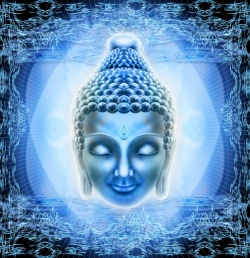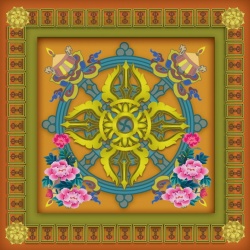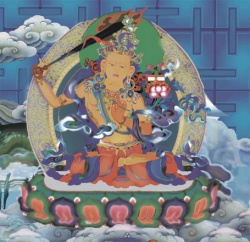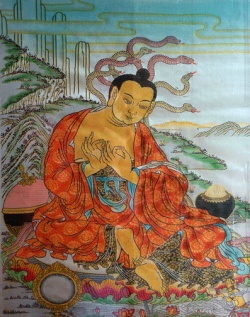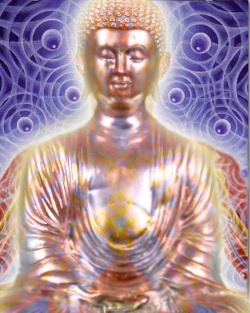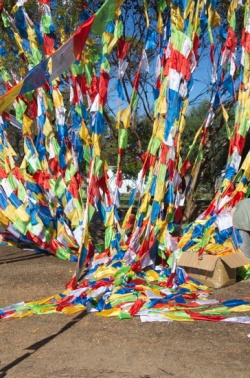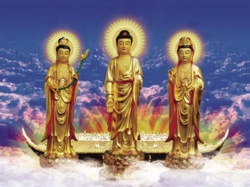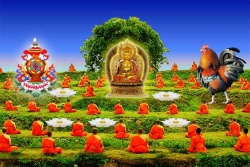Difference between revisions of "Tsok Practice"
| Line 1: | Line 1: | ||
| − | <nomobile>{{DisplayImages|4472|1733|310|2700|3669|3151|1708|4378 | + | <nomobile>{{DisplayImages|4472|1733|310|2700|3669|3151|1708|4378}}</nomobile> |
Revision as of 12:22, 18 December 2015
I will first talk about the refuge vow for those who are interested in taking refuge. Refuge is the entrance to the practice of Buddhism. As we pursue enlightenment, we must rely on others for guidance.
The Three Jewels are sources of refuge, since they have achieved freedom from suffering. One cannot take refuge from those who have not already been liberated.
One needs to take refuge in the Buddha, a fully enlightened being. In the beginning he developed bodhicitta, in the middle he practiced meritorious deeds, and in the end he achieved enlightenment for the sake of all beings.
By taking refuge in Buddha, one also takes refuge in the Dharma, which is the path to enlightenment, showing us what to avoid and what to practice.
One also needs to take refuge in the Sangha, the practitioners who have followed the path and kept alive the lineage of oral instructions and practice.
One should not misunderstand refuge to be like a leader who is very high and we, the followers, are very low. One should recognize Buddha as the teacher, the dharma as his teaching, and sangha as our companions on the path.
One takes refuge with great joy and pleasure thinking one is taking refuge to bring oneself to ultimate enlightenment. One should take great joy and satisfaction in taking refuge, knowing that it leads to lasting happiness.
A Tibetan king in Western Tibet had his kingdom invaded by a Muslim army. He was captured and put in prison and was given three options. The first was to renounce the dharma.
The second was to pay a ransom equal to his weight in gold. The third was to die in prison. He thought I will not even say the words, "I will renounce the dharma," even if I do not mean it.
One should take refuge with the motivation that one will achieve enlightenment for the sake of all sentient beings. One should be free of the thought of receiving the vow for one's own benefit.
One should think one is taking the vow for the benefit of others, so they might be brought to full enlightenment. To take the vow, you repeat it three times.
It is said that refuge vow is the basis of all other vows. You should think you are taking the vow from all the Buddhas and not from an ordinary person. Your benefit is dependent on your attitude, as all phenomena are dependent on causes and conditions.
The verse says, "Buddhas and bodhisattvas, please listen to my request. Master, please listen to my request.
I, NAMED, am taking refuge in the Buddha, supreme among persons, until I attain complete enlightenment. Please make me a lay precept holder."
There are five lay precepts and one can take a commitment to take one or all five of them. Regarding the vow of intoxicants.
If one takes this precept one can take a small amount of alcohol, but not so much that one becomes drunk. Repeating these verses three times, the third time one should resolve to keep these precepts.
The topic for today is the feast offering. The practice starts with taking refuge and generating the mind of enlightenment. One invokes the guru and makes offering, prostrations, beseeching, and so forth to him.
Feast offering is meritorious. It's not supposed to be a tea party. But even if it seems like that, there is still a great deal of merit.
The recommended days for feast offerings are the tenth, twenty fifth, and thirtieth days of the lunar month.
The tenth is Guru Padmasambhava's day and the twenty fifth is dakini day. Another tradition is to do tsok offering at the completion of a teaching.
Also when one completes a retreat it is traditional to do a tsok to signify one's gratitude. It is also done to revive the samaya between teacher and student.
Tsok literally means collection. This refers to the collection of different substances.
The first is the collection of fortunate beings. If the feat offering is performed with dakas or dakinis it is known as the gathering of dakas or dakinis.
The second collection is the collection of wealth and riches. This is all eatable food and drinks. The main purpose of the second collection is to purify one's ordinary perception of regarding some things as clean and others as unclean. One uses the five nectars and meats in symbolic form on the altar.
By consuming them one purifies one perception of seeing them as unclean. The five meats are horse, cow, elephant, dog, and human. Cow is not considered impure in America, but it was in India.
The five nectars are blood, urine, feces, semen, and brain. The text explains how these are placed in the four directions and center.
When engaging in the generation stage practices one starts with the dissolution of everything into emptiness by reciting the mantra. This is done in order to eliminate self-grasping.
From within emptiness the syllable YAM in a crescent moon arises, symbolizing wind. Then the syllable RAM in a triangle arises above it, symbolizing fire.
Then from the syllable KAM arises a tripod of skulls. The skull which is the cauldron sits on the tripod. It is white on the outside and red on the inside.
It is vast. In the center one pours urine in the form of the syllable HUNG. On the east one puts feces in the form of the syllable OM.
In the north one puts brain in the form of the syllable KAM.
In the west one puts semen in the syllable ANG.
In the south one puts blood in the form of the syllable TRAM.
Then one puts fire in the form of HUNG.
In the center of the five nectars one places human flesh in the form of the syllable HUNG.
In the southeast corner one puts cow meat in the form of the syllable LAM.
In the southwest one places dog meat in the form of the syllable MAM.
In the northwest one places elephant meat in the form of the syllable HAM.
In the northeast one puts horse meat in the form of the syllable TAM.
The wind swirls around, generating fire out of the syllable RAM.
This boils the substances in the skull cup, melting the five meats and nectars. As they boil, their color becomes orange red like the rays of the rising sun.
The mandala of the moon is placed as a lid on the skull. On top of it are a white OM, a red AH, and a blue HUNG.
Light rays radiate from the three syllables in the ten directions, reaching the Buddhas and bodhisattvas whose wisdom nectars are drawn back and dissolve into the vessels.
The wisdom and samaya nectars become one and become white in color, cool in temperature, sweet in taste, and abundant in power. This becomes the collection of wealth and riches.
The third collections is the all fulfilling gods and goddesses. One invites whatever deity one is practicing and makes offerings to them. First one visualizes oneself as the deity.
Tsok means collection or assembly We have described the three collections, now we describe the three mandalas.
The first is the body mandala of the dakinis, their emblems, and instruments.
The second is the mandala of speech and melody.
The third is the mind mandala of bliss and emptiness.
This refers to the wisdom free of conceptions of pure and impure, high and low, that perceives all of samsara and nirvana as equal.
There are six types of satisfaction that come from consuming the feast.
The first is by taking the substances of the feast, it generates tummo, which generates heat and wisdom, which satisfies the hundred deities in the body mandala.
The second is the satisfaction of the wisdom deities by the nectar.
If one offers even one's hatred, the white feast offering generated from the transformation of one's hatred provides satisfaction to the deities. The same applies to each of the poisons.
The third is the satisfaction of the inner and outer dakinis through songs and dances.
These are the outer dakinis of the twenty four and thirty two holy places and the inner dakinis dwelling within the chakras and channels of one's body.
The secret dakinis issue from the expression of one's mind.
The fourth is the satisfaction of bliss and emptiness of the body mandala.
When you consume the feast offerings you feel fulfilled and generate the wisdom of bliss and emptiness.
The fifth is the satisfaction of meditation by meditating on the mandala of the deities.
The sixth is the satisfaction of the spirits by receiving the remainders of the feast offerings. So these are the six satisfactions.
Drupon Thinley Ningpo December 31, 2006 Tibetan Meditation Center
Source
http://medicinebuddhasangha.org/teachings/tsok_practice.html
